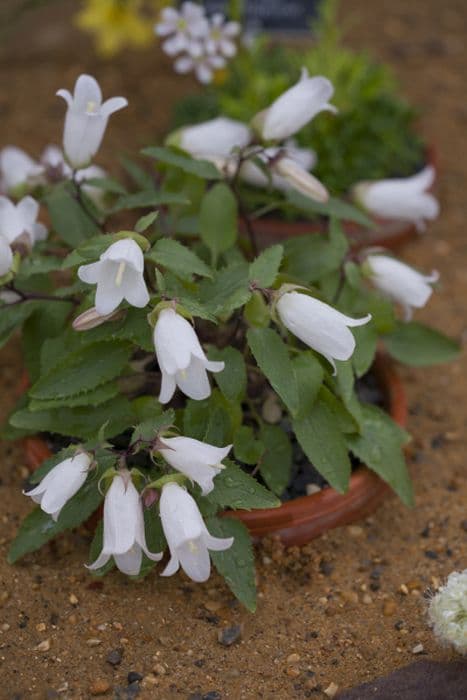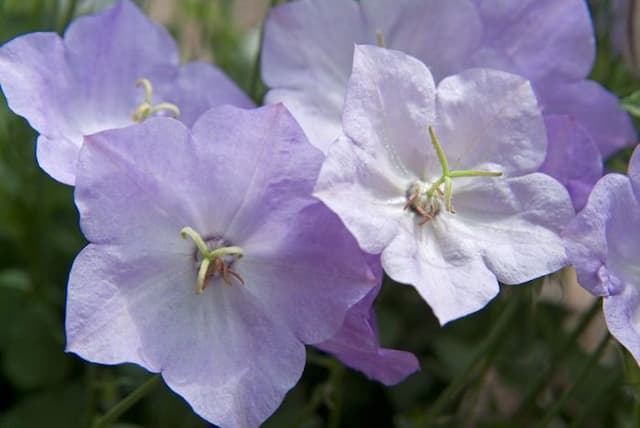Serbian Bellflower Campanula poscharskyana 'E.h. Frost'

ABOUT
Campanula poscharskyana 'E.H. Frost', commonly known as the trailing bellflower or Serbian bellflower, is a delightfully charming plant that features a cascade of heart-shaped leaves, which often have a lush, vibrant green color. The foliage provides a lush backdrop for the striking flowers. The blooms are star-shaped with a radiant white hue and a subtle lavender blush, typically with five pointed lobes that create a whimsical starry pattern. These flowers possess a gentle, yet enticing beauty, which is further highlighted by the contrast between their pastel tones and the greenery. The blossoms are borne in loose clusters, creating a soft, frothy appearance as if a light dusting of snowflakes had settled atop the foliage. The trailing bellflower boasts a vigorous and spreading habit, often forming a low, mat-like ground cover, which practically makes it a living carpet of foliage and flowers during its blooming season. This plant's effusive charm and cascading form make it particularly well suited for embellishing rock gardens, wall crevices, or for draping over the edges of containers, where its beauty can be showcased and adored.
About this plant
 Names
NamesFamily
Campanulaceae
Synonyms
Serbian Bellflower, Trailing Bellflower, Blue Waterfall
Common names
Campanula poscharskyana 'E.H. Frost'.
 Toxicity
ToxicityTo humans
The Serbian Bellflower, as Campanula poscharskyana is commonly known, is not generally considered toxic to humans. It is not associated with any significant symptoms of poisoning, as it is not known to contain any substances hazardous to human health in quantities that could cause harm when handled or ingested incidentally. Therefore, accidental ingestion of the Serbian Bellflower is not typically a cause for concern regarding human toxicity.
To pets
The Serbian Bellflower is also not known to be toxic to pets. It is generally considered safe for dogs, cats, and other domestic animals, and there are no common symptoms of poisoning associated with this plant. Ingesting parts of the Serbian Bellflower should not lead to any significant adverse health consequences for pets. However, individual animals may have varying sensitivities, and it is always a good practice to monitor pets if they consume any plant material to ensure they do not exhibit any signs of distress.
 Characteristics
CharacteristicsLife cycle
Perennials
Foliage type
Semi-deciduous
Color of leaves
Green
Flower color
White
Height
0.5 feet (15 cm)
Spread
2 feet (60 cm)
Plant type
Creeper
Hardiness zones
3
Native area
Balkans
Benefits
 General Benefits
General Benefits- Low Maintenance: Campanula poscharskyana 'E.H. Frost', commonly known as Serbian Bellflower, is known for its ease of care, making it suitable for gardeners of all experience levels.
- Drought Tolerance: Once established, Serbian Bellflower is relatively drought-resistant, reducing the need for frequent watering.
- Ground Cover: Its spreading habit makes it an excellent choice for covering large areas, controlling erosion and suppressing weeds.
- Attracts Pollinators: The flowers of Serbian Bellflower attract bees, butterflies, and other beneficial insects, promoting biodiversity in the garden.
- Ornamental Value: With its star-shaped, white flowers and verdant foliage, it provides aesthetic appeal to garden borders, rock gardens, and containers.
- Cold Hardy: It is a cold-tolerant plant, thriving in many climates and able to withstand frost and cold temperatures.
- Long Bloom Time: Serbian Bellflower offers a long flowering period from late spring to early autumn, ensuring continuous color in the garden.
- Fast Growth: This plant grows quickly, allowing for rapid establishment and filling in garden spaces in a short time frame.
- Versatile: It adapts well to various conditions and can be planted in full sun to part shade, accommodating different garden designs.
 Medical Properties
Medical PropertiesThis plant is not used for medical purposes.
 Air-purifying Qualities
Air-purifying QualitiesThis plant is not specifically known for air purifying qualities.
 Other Uses
Other Uses- Photography subject: Campanula poscharskyana 'E.h. Frost', commonly known as trailing bellflower, can be an excellent subject for macro photography due to its delicate blossoms and intricate details.
- Art inspiration: The trailing bellflower's cascading habit and starry flowers can inspire botanical illustrations and garden-themed artworks.
- Education: Trailing bellflower can be used in school projects or educational programs to teach about plant growth habits, pollination, and perennial life cycles.
- Fairy gardens: Because of its diminutive size and sprawling nature, the trailing bellflower is an ideal plant to include in fairy garden designs, creating a whimsical miniature landscape.
- Eco-friendly confetti: The dried petals can be used as biodegradable confetti for outdoor celebrations, reducing the environmental impact compared to traditional plastic confetti.
- Theme gardens: Trailing bellflower can be used in blue-themed gardens or moon gardens, where its silvery foliage and pale blue flowers will shine in the moonlight.
- Culinary decoration: While not commonly consumed, the fresh blossoms can be used as a decorative edible garnish for cakes and desserts, provided they are free of pesticides.
- Bonsai companion planting: Trailing bellflower can be used in bonsai culture as an accompanying plant to create a sense of scale and enhance the display of bonsai trees.
- Floral crafts: The flowers and foliage can be pressed and used in creating natural art such as pressed flower bookmarks or greeting cards.
- Seasonal centerpiece: The trailing branches and flowers of the bellflower can be incorporated into live table centerpieces for summer events, adding a touch of elegance and natural beauty.
Interesting Facts
 Feng Shui
Feng ShuiThe Serbian Bellflower is not used in Feng Shui practice.
 Zodiac Sign Compitability
Zodiac Sign CompitabilityThe Serbian Bellflower is not used in astrology practice.
 Plant Symbolism
Plant Symbolism- Constancy and Perseverance: Campanula poscharskyana 'E.H. Frost', commonly known as the trailing bellflower, often symbolizes constancy and perseverance due to its hardy nature and ability to survive in tough conditions.
- Gratitude: The bell-shaped flowers of the trailing bellflower can also represent gratitude, making it a thoughtful gift for someone to whom you want to express thanks.
- Humility: The modest and delicate appearance of the trailing bellflower may symbolize humility, suggesting a gentle and unassuming quality.
- Enduring Love and Affection: This plant is sometimes associated with everlasting love and affection, with its recurring blooms representing the enduring nature of deep emotional connections.
 Water
WaterThe Serbian Bellflower, as Campanula poscharskyana 'E.H. Frost' is commonly known, prefers evenly moist soil, but it should not be waterlogged. It is best to water this plant when the top inch of soil feels dry to the touch. Water the plant thoroughly, allowing the water to soak in and reach the roots, but be sure to avoid standing water. In hot conditions or when the plant is actively growing in spring and summer, you might need to water once or twice a week, using about 1-2 gallons per plant, depending on size and soil conditions. During cooler months or when the plant is dormant, reduce the watering frequency.
 Light
LightSerbian Bellflower thrives in full sun to partial shade. It performs best in a spot that receives at least 6 hours of sunlight per day. However, in areas with very hot summer sun, it benefits from light afternoon shade to prevent scorching its leaves. Morning sun with dappled afternoon light is ideal for promoting a healthy growth and abundant flowering.
 Temperature
TemperatureSerbian Bellflower is hardy and can withstand a range of temperature conditions. It prefers a temperate climate and thrives in temperatures between 60 to 75 degrees Fahrenheit. It can survive minimum temperatures down to about -30 degrees Fahrenheit and is generally hardy in USDA zones 3 to 8. Consistent temperatures within the ideal range promote the best growth and flowering.
 Pruning
PruningThe Serbian Bellflower benefits from pruning to maintain its shape and encourage denser growth. Prune in the spring just after new growth begins, cutting back any dead or overgrown stems. Deadheading, or removing spent flowers, promotes additional blooming and should be done regularly throughout the flowering season. Major pruning is not often necessary; however, a light trim can be given after the main flowering period to tidy up the plant and remove any straggly growth.
 Cleaning
CleaningAs needed
 Soil
SoilThe best soil mix for the trailing bellflower is well-drained, fertile loam with a pH range of 6.0 to 8.0. Amend regular potting soil with compost and perlite for improved drainage and nutrients.
 Repotting
RepottingTrailing bellflowers should be repotted every 2-3 years to refresh the soil and accommodate the growing root system.
 Humidity & Misting
Humidity & MistingTrailing bellflowers prefer moderate humidity levels but are adaptable to various indoor conditions as long as they are not in extremely dry air.
 Suitable locations
Suitable locationsIndoor
Place in bright, indirect light and water regularly.
Outdoor
Plant in partial shade and well-draining soil, water when dry.
Hardiness zone
3-8 USDA
 Life cycle
Life cycleThe life of Campanula poscharskyana 'E.H. Frost', commonly known as 'Serbian Bellflower', begins with seed germination, which occurs in moist, well-drained soil with adequate light exposure. The seedlings then develop into rosettes of heart-shaped leaves, from which trailing stems emerge, spreading outward or downward depending on their support. Vegetative growth continues with leaves and stems becoming more robust, and the plant may also spread through runners. Flower buds form, usually in late spring to early summer, leading to star-shaped, light blue to white flowers that bloom for several weeks. After pollination, typically by bees, the flowers develop into small capsules containing seeds, which get dispersed to start new plants. Finally, the plant enters dormancy in winter, with the foliage often dying back, before re-emerging in spring to repeat the cycle.
 Propogation
PropogationPropogation time
Spring to early summer
Propogation: The Serbian Bellflower 'E.H. Frost', a variant of Campanula poscharskyana, is commonly propagated by division, which is the most popular method for this perennial plant. The best time for dividing Serbian Bellflowers is in the spring or early fall when the plant is not in bloom. To propagate by division, one should carefully dig up an established clump of the plant and then gently separate the clump into smaller sections, making sure that each section has a portion of the root system along with some shoots. These sections can then be replanted in well-prepared soil at the same depth they were growing previously, spaced about 12 inches (or about 30 centimeters) apart to allow sufficient room for growth. After planting, it's essential to water the new divisions thoroughly to help establish them. The divisions will typically take root and start to grow quickly, given adequate moisture and light.









